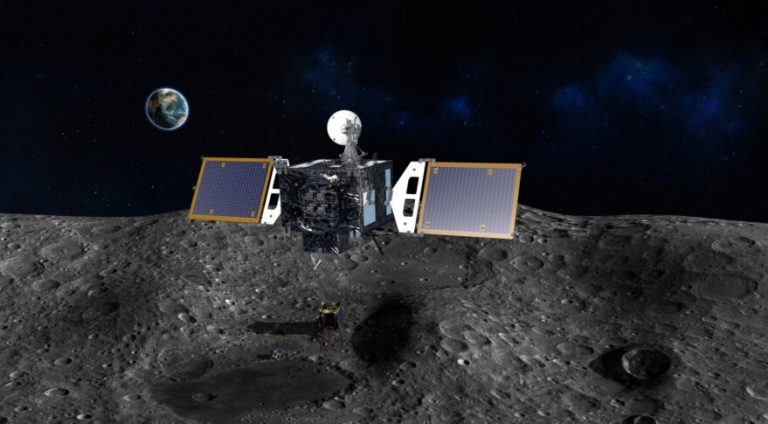
The ministry said the spacecraft would conduct four more propulsive maneuvers with its thrusters by Dec. 28 to steer it into a circular, low-altitude orbit about 100 kilometers from the lunar surface by Dec. 29.
By Park Si-soo
SEOUL, South Korea
South Korea’s first robotic lunar orbiter, Danuri, entered the lunar orbit after conducting its first lunar orbit insertion maneuver Dec. 16.
The orbiter is circling the moon in an elliptic orbit every 12.3 hours, with a perigee of 109 kilometers and an apogee of 8,920 kilometers, said the science ministry in a Dec. 19 statement.
The first maneuver, done with the firing of thrusters for thirteen minutes from 12:45 p.m. Eastern, “reduced the speed of Danuri from about 8,000 kilometers per hour to 7,500 kilometers per hour,” the ministry said in the statement. “It was confirmed that Danuri had been trapped in lunar gravity in a stable manner, which means it has become a genuine lunar orbiter.”
The ministry said the spacecraft would conduct four more propulsive maneuvers with its thrusters by Dec. 28 to steer it into a circular, low-altitude orbit about 100 kilometers from the lunar surface by Dec. 29. If successful, the 678-kilogram orbiter will go through a brief period of commissioning and tests to begin its yearlong mission from January, with six scientific instruments aboard, including NASA-funded hypersensitive optical camera ShadowCam. The camera is set to collect images of permanently shadowed regions near the moon’s poles to search for evidence of ice deposits, observe seasonal changes, and measure the terrain inside the craters. Collected data will be shared with NASA, which aims to send humans to the moon in the coming years under its Artemis program.
The Korean orbiter, also known as Korea Pathfinder Lunar Orbiter (KPLO), launched into space Aug. 4 on a SpaceX Falcon 9 rocket from Cape Canaveral Space Force Station’s Launch Complex 40. It flew to the moon on a ballistic lunar transfer trajectory, which initially took the spacecraft toward the sun and looped it back to the moon. The route, while much longer than traveling directly toward the moon, allows more fuel efficiency as it leverages the sun’s gravity for travel.
While going to the moon, the orbiter demonstrated “space internet” by sending video and photo files, including a popular Korean band’s music video, at a distance of more than 1.2 million kilometers to Earth. The demonstration was conducted twice — Aug. 25 and Oct. 28 — using a space internet demonstrator developed by the Electronics and Telecommunications Research Institute (ETRI) here, validating an interplanetary internet connection using delay-disruption tolerant networking.
The spacecraft also sent photos of the Earth and the moon’s orbit it took between Sept. 15 and Oct. 15 using a built-in high-resolution camera at a distance of between 1.46 million kilometers and 1.548 million kilometers to Earth.
The Danuri mission marks the beginning of South Korea’s deep space exploration initiative. The country’s leader recently pledged to land a robotic spacecraft on the moon in 2032 and on Mars in 2045. To that end, the government is planning to invest 2.13 billion won ($1.63 billion) in developing a next-generation rocket, KSLV-3, a two-stage vehicle capable of putting up to seven tons of payload into sun-synchronous orbit, 3.7 tons into geostationary transfer orbit, and 1,8 tons into Earth-Moon transfer orbit. As part of this, the Korea Aerospace Research Institute (KARI) is working to develop kerosene-fueled 100-ton thrust engines in five years.
The leader also promised to double the government’s space development budget in the next five years and funnel at least 100 trillion won ($76.7 billion) into the space sector by 2045. South Korea’s space budget for 2022 is 734 billion won ($563 million).
__________________
Courtesy: Space News (December 19, 2022)